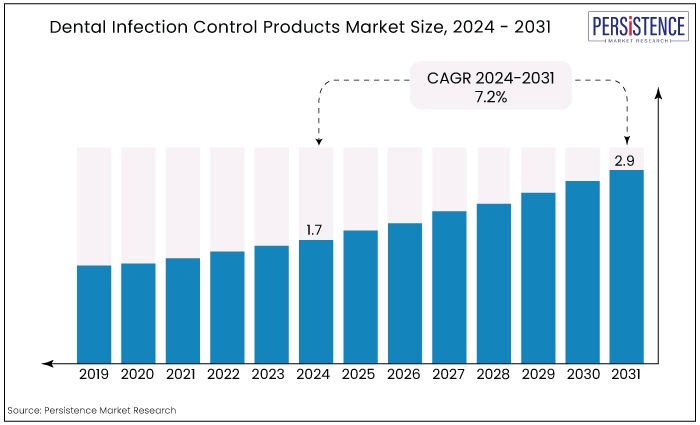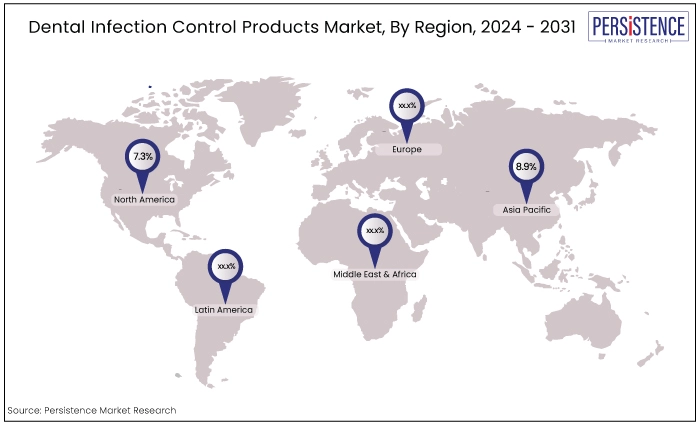Industry: Healthcare
Format: PPT*, PDF, EXCEL
Delivery Timelines: Contact Sales
Report Type: Ongoing
Report ID: PMRREP34633
The global dental infection control products market is estimated to value at US$2.9 Bn by the end of 2031 from US$1.7 Bn recorded in 2024. The market growth is expected to secure a CAGR of 7.2% during 2024-2031.
Key Highlights of the Market
|
Market Attributes |
Key Insights |
|
Market Size (2024E) |
US$1.7 Bn |
|
Projected Market Value (2031F) |
US$2.9 Bn |
|
Forecast Growth Rate (CAGR 2024 to 2031) |
7.2% |
|
Historical Growth Rate (CAGR 2018 to 2023) |
6.4% |
The market is essential for maintaining hygiene and preventing infections in dental practices worldwide. With dental procedures increasing in complexity and frequency, the demand for effective infection control measures has grown significantly.
The dental infection control products market growth is driven by heightened awareness among dental professionals and patients about infection prevention, supported by strict regulatory guidelines. These regulations mandate the use of sterilization equipment, disinfectants, and personal protective equipment (PPE) to ensure compliance and patient safety.
Technological advancements play a crucial role, with innovations in sterilization techniques such as autoclaves and chemical sterilants improving efficacy and speed.
Advanced disinfectants are also developed to target a wide range of pathogens effectively. Product categories include surface disinfectants, instrument sterilization equipment, PPE such as masks and gloves, and barriers like chair covers and tray liners.
Each category addresses specific needs within dental settings to maintain sterile environments and prevent cross-contamination. The market expansion is primarily driven by increasing awareness, technological advancements, and regulatory requirements, ensuring safe and effective infection prevention in dental practices globally.
Historical Growth and Course Ahead
The dental infection control products market has shown steady historical growth driven by rising dental procedures, stringent infection control regulations, and technological advancements in sterilization and disinfection.
Historically, North America have been key regions due to established healthcare systems and high regulatory standards. However, regions like Asia-Pacific are experiencing rapid growth due to increasing dental care demand and improving healthcare facilities.
Looking ahead, the market is poised for further expansion globally. Factors such as increasing awareness about infection prevention, especially in emerging economies, and the adoption of advanced sterilization technologies are expected to drive growth.
Innovations in disinfectants targeting a broader spectrum of pathogens and improvements in PPE and barrier products will also play significant roles.
Furthermore, the ongoing integration of digital technologies in dental practices, including digital sterilization monitoring and compliance systems, is anticipated to reshape market dynamics. This evolution underscores a commitment to enhancing patient safety and compliance with evolving healthcare standards worldwide.

Worldwide Increase in Number of Dental Procedures
The growing number of dental surgeries and treatments globally reflects increasing awareness of oral health and advancements in dental care. As populations age and dental aesthetics gain importance, procedures like implants, orthodontics, and cosmetic dentistry are becoming more common.
Technological innovations, such as CAD/CAM systems for prosthetics and laser dentistry, are also reshaping the field, offering precise treatments with faster recovery times. This trend is supported by rising disposable incomes in emerging markets, where dental tourism is flourishing.
However, challenges like access to affordable care and disparities in oral health outcomes persist, highlighting the need for broader healthcare reforms and improved preventive strategies globally.
Increasing Awareness Regarding Infection Control
Increasing awareness of infection control in dentistry has catalysed the growth of the dental infection control products market. With stringent regulations and rising concerns about healthcare-associated infections (HAIs), dental practices are adopting advanced sterilization and disinfection protocols.
The shift is bolstered by innovations in antimicrobial materials, disposable instruments, and effective surface disinfectants tailored for dental settings. The market is also driven by heightened patient expectations for safe treatment environments.
However, cost constraints and the complexity of compliance with evolving regulatory standards pose challenges. Despite these hurdles, the market is poised for expansion, fueled by ongoing investments in research and development aimed at enhancing infection prevention measures in dental care globally.
Expensive Capital Requirement for Advanced Infection Control Equipment
The significant initial investment required for advanced infection control equipment poses a challenge for dental practices, particularly smaller clinics and new entrants.
High costs associated with purchasing autoclaves, ultrasonic cleaners, air purification systems, and other state-of-the-art sterilization technologies can strain budgets.
Additionally, ongoing expenses for maintenance, training staff, and complying with stringent regulatory standards further escalate financial commitments.
Despite these hurdles, investing in top-tier infection control equipment is crucial for ensuring patient safety, enhancing practice reputation, and minimizing the risk of healthcare-associated infections.
While the initial outlay is substantial, the long-term benefits, including improved patient trust and potential reduction in liability, underscore the importance of prioritizing infection control investments.
Limited Adoption in Developing Countries
The limited adoption of dental infection control products in developing countries is primarily due to economic constraints and lack of awareness. High costs associated with advanced sterilization equipment, disposable instruments, and comprehensive infection control protocols are prohibitive for many clinics operating on tight budgets.
Additionally, inadequate training and limited access to updated guidelines hinder the implementation of effective infection control measures. While international organizations and local governments are making efforts to improve dental care standards, progress is slow.
The challenge is further compounded by disparities in healthcare infrastructure. Addressing these issues requires targeted investments, education programs, and subsidies to make advanced infection control products more accessible and affordable in these regions.
Increasing Focus on Preventative Healthcare Initiatives
The increasing focus on preventative healthcare initiatives highlights a shift towards proactive health management.
Governments, healthcare providers, and organizations are prioritizing early detection and preventive measures to reduce the incidence of chronic diseases and improve overall public health. Initiatives include widespread vaccination programs, regular health screenings, public education campaigns, and the promotion of healthy lifestyles.
Advances in technology, such as wearable devices and telehealth services, support these efforts by enabling continuous health monitoring and early intervention. This approach not only enhances quality of life but also alleviates the burden on healthcare systems, making care more sustainable and cost-effective in the long run.
Growing Dental Tourism in Developing Economies
Dental tourism is burgeoning in emerging economies, driven by the affordability and high quality of dental care. Countries like India, Mexico, and Thailand are becoming popular destinations for patients seeking cost-effective dental treatments.
Market growth in these countries is spurred by advanced dental facilities, skilled practitioners, and shorter wait times compared to developed nations. The influx of international patients necessitates stringent infection control measures to maintain high standards of care.
Consequently, the dental infection control products market in these regions is expanding. Clinics are investing in state-of-the-art sterilization equipment, single-use disposables, and advanced air purification systems to ensure patient safety and meet global hygiene standards.
Moreover, the rising demand for dental tourism is prompting local governments and private investors to improve healthcare infrastructure. This includes adopting innovative infection control technologies, which further fuels the market growth, enhancing the overall quality and reputation of dental services in these emerging economies.
|
Category |
Projected CAGR through 2031 |
|
Type – Equipment |
15.2% |
|
End-Use– Hospitals and Clinics |
13.7% |
Equipment Remain the Top-Sought Product Type Category
The equipment segment commands a substantial share in the dental infection control products market, driven by the critical need for effective sterilization and hygiene in dental practices.
Key equipment includes autoclaves, ultrasonic cleaners, and washer-disinfectors, essential for sterilizing instruments and ensuring a sterile environment.
Technological advancements have enhanced the efficiency and reliability of these devices, making them indispensable in modern dental clinics. The rising awareness of infection control and the growing emphasis on patient safety further boost demand for such equipment.
Additionally, regulatory guidelines and standards necessitate the use of high-quality sterilization equipment, contributing to the segment's dominance. As dental practices continue to prioritize infection control, the equipment segment is poised for sustained growth in the market.
Hospitals and Clinics Continue to Register the Highest Adoption Rates
Hospitals and clinics are the dominant end users in the dental infection control products market, primarily due to their high patient footfall and the critical need for stringent hygiene practices.
These healthcare facilities invest significantly in infection control measures, including sterilization equipment, disposable barriers, and advanced air purification systems, to prevent cross-contamination and ensure patient safety.
The increasing awareness of infection risks and adherence to regulatory standards drive the demand for comprehensive infection control solutions in hospitals and clinics.
Additionally, the growing prevalence of dental procedures performed in these settings further boosts the need for effective infection control products, solidifying their dominance in the market.
|
Region |
CAGR through 2034 |
|
North America |
7.3% |
|
Asia Pacific |
8.9% |
North America Ranks Top with a Priority to Infection Prevention
North America is expected to account for a significant share of the dental infection control products market, driven by the region's advanced healthcare infrastructure, and high awareness of infection prevention.
The stringent regulatory standards and guidelines enforced by organizations such as the CDC, and FDA ensure the widespread adoption of sophisticated infection control measures in dental practices.
Moreover, the high prevalence of dental procedures and the growing geriatric population contribute to the increasing demand for effective infection control products.
Technological advancements and continuous innovation by key market players further bolster the market growth in North America, positioning the region as a leader in the dental infection control sector.
Asia-Pacific Emerges as Fastest-Growing Market for Dental Infection Control Products
The Asia-Pacific region is emerging as the fastest-growing market for dental infection control products, driven by rapid advancements in healthcare infrastructure and increasing awareness of infection prevention.
Countries like China, India, and Japan are witnessing a surge in dental procedures, necessitating stringent infection control measures.
The region's expanding middle class and rising disposable incomes contribute to higher healthcare spending, including dental care. Additionally, supportive government initiatives and investments in healthcare facilities further propel market growth.
Asia Pacific therefore is rapidly gaining prominence in the global landscape, offering significant growth opportunities for industry stakeholders.

The dental infection control products market is highly competitive, with key players like 3M, Dentsply Sirona, and Henry Schein leading the way.
Continuous innovation, strategic mergers, and acquisitions, alongside robust research and development, drive competition, aiming to meet the growing demand for advanced infection control solutions.
Recent Industry Developments
June 2022
Henry Schein, Inc. (Nasdaq: HSIC), the leading provider of healthcare solutions for dental and medical professionals in office settings worldwide, has entered into a definitive agreement to acquire Condor Dental Research Company SA (Condor Dental). Condor Dental is a privately owned dental distribution company based in Switzerland, catering to dental general practitioners, specialists, and laboratories.
April 2024
HuFriedyGroup, a prominent name in the dental sector renowned for its leadership in hand instruments and infection control products, is set to be acquired by an affiliate of Peak Rock Capital. The middle-market private equity firm's affiliate has officially entered into a definitive agreement to acquire HuFriedyGroup, the dental segment of STERIS plc.
|
Attributes |
Details |
|
Forecast Period |
2024 to 2031 |
|
Historical Data Available for |
2018 to 2023 |
|
Market Analysis |
US$ Billion for Value |
|
Key Regions Covered |
|
|
Key Market Segments Covered |
|
|
Key Companies Profiled in the Report |
|
|
Report Coverage |
|
|
Customization & Pricing |
Available upon request |
By Type
By Region
To know more about delivery timeline for this report Contact Sales

The demand for dental infection control products is surging due to heightened awareness of hygiene, regulatory requirements, increasing dental procedures, and concerns over infectious diseases in clinical settings.
Innovations like advanced sterilization technologies, single-use disposables, eco-friendly materials, and digital monitoring systems are shaping the dental infection control products market, enhancing safety and efficiency.
Dental infection control products are governed by stringent regulations ensuring safety and efficacy, encompassing guidelines on sterilization, disinfection, material safety, and environmental standards.
Future trends in the dental infection control products market include increased adoption of automation, integration of IoT for monitoring, development of eco-friendly materials, and advancements in sterilization technologies.
North America is to account for the significant share in the market.